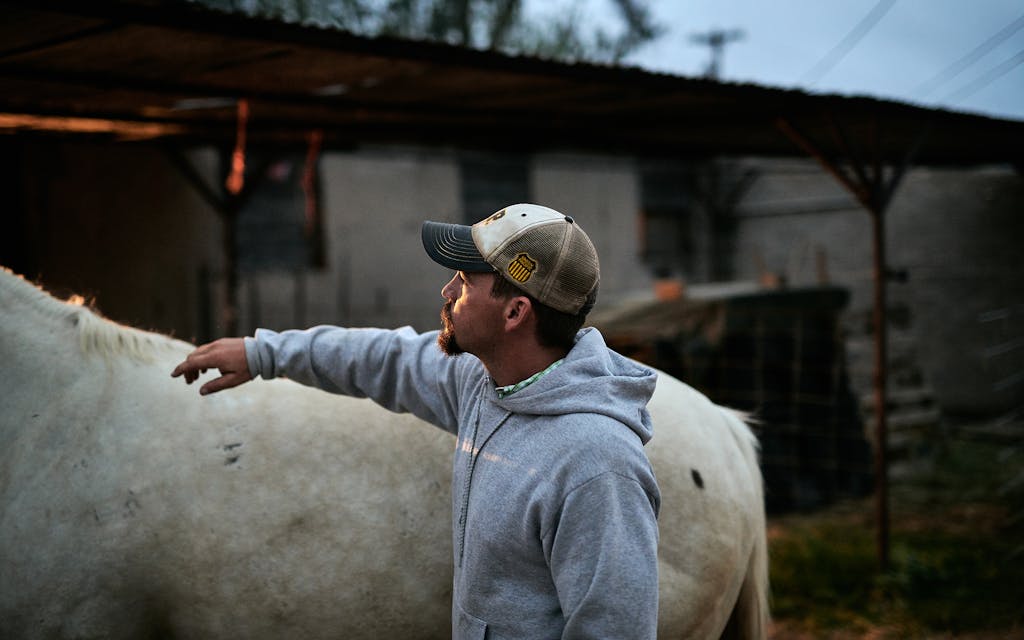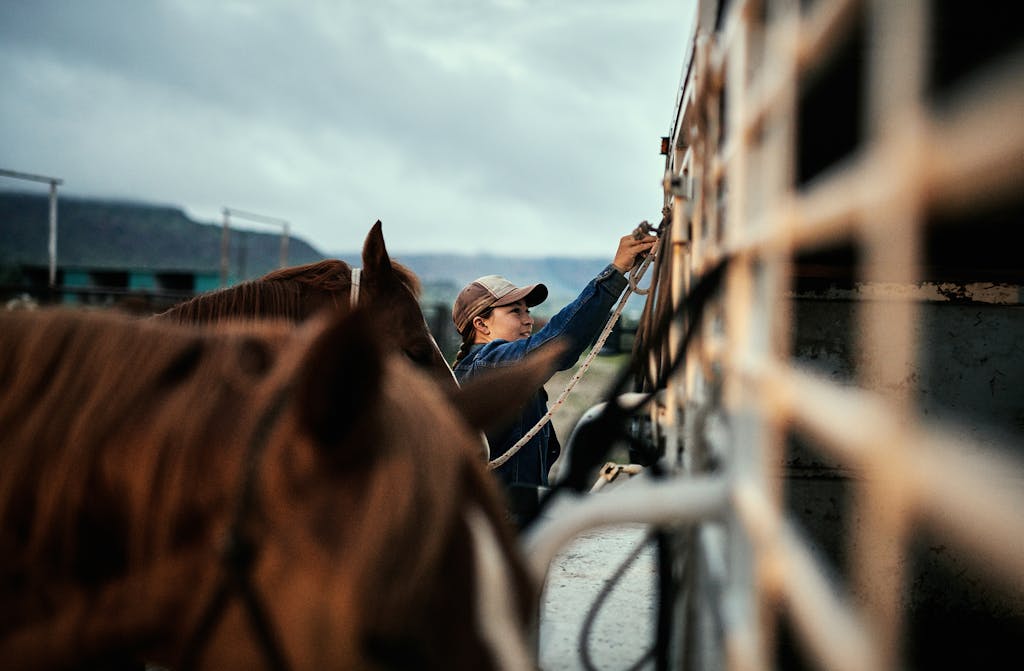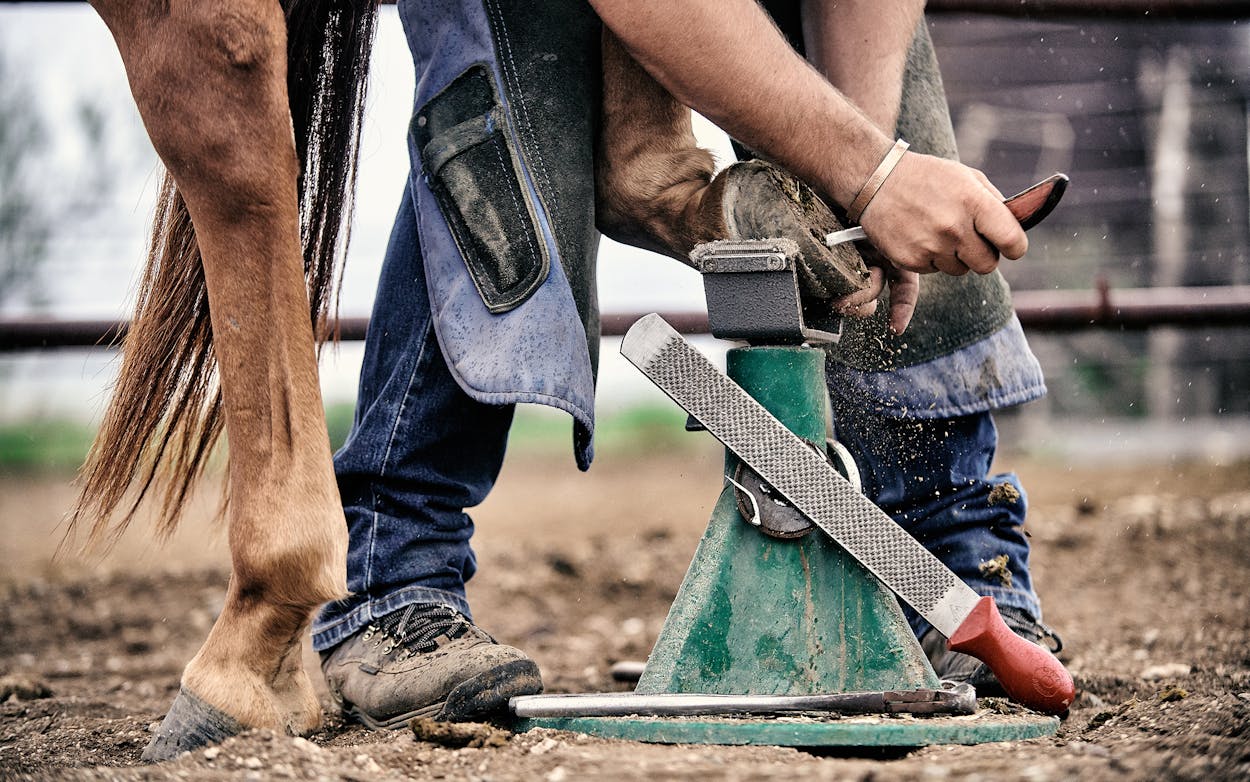Colby Smith is a farrier, a shoer of horses. Accompanied by his wife, Jess, who is also his assistant, he circuits far West Texas every four to six weeks, trimming hooves and nailing shoes onto his clients’ horses, ponies, mules, and donkeys. “When I was fourteen, I started working with farriers to see if I could do it,” he said as the couple drove from their Alpine home to a job in Fort Stockton. “I wanted to learn because I didn’t want to have to pay someone else to do it.”
A native of New York state, Colby received his first pony at age four and competed in roping throughout high school. He went west, to Tucumcari, New Mexico, and completed a farrier science program before landing in Alpine to rodeo for Sul Ross State University. It was there, in 2011, he met Jess, a goat-tying and breakaway-roping competitor who’d just started at Sul Ross on a rodeo scholarship. They’ve rarely been apart since. “We started dating that fall and got married in ’14,” said Colby. “The rest has been her torture.”
Colby worked as a farrier throughout college and continued after graduation. When Jess finished graduate school at Sul Ross, she joined him on the road, pulling shoes, handing him tools, finishing feet, and dealing with clients. “I am solid labor, and she is definitely the brains,” he said. On the way to Fort Stockton, he was still riding high from a recent job in which they’d teamed to do 49 head in four days. “That,” Colby said with a curt nod, “is a lot of horses.” They shod so many that they ran out of shoes and had to postpone another client until more arrived in the mail. “We worked our way right out of a job,” he said.

The old saying is “no hoof, no horse.” Ancient ancestors of modern horses had multiple toes. As the climate changed and swampy forests gave way to broad, grassy prairies, horses grew larger, their legs became longer, and their toes disappeared until only a single one remained. That’s their hoof. Their hooves are tiny in proportion to the big body they carry, and, in an engineering marvel, the hooves can bear tremendous concussive force as the horse runs. At one point in the stride, the horse’s one thousand pounds are balanced on one foot, that single toe.Humans domesticated horses perhaps as far back as 10,000 years ago, though it’s not known exactly when people climbed on their backs and began riding. By around 400 BC, horses were ingrained enough in human society that the Greek historian Xenophon wrote a treatise called On Horsemanship, which included advice about the importance of a horse’s feet. “Just as a house would be of little use, however beautiful its upper stories, if the underlying foundations were not what they ought to be, so there is little use to be extracted from a horse, and in particular a war-horse, if unsound in his feet.”
Hooves, like toenails, constantly grow. Feral horses travel great distances across varied terrain each day to graze, which wears their feet down naturally. Domestic horses kept in barns, pens, or pastures don’t typically have that opportunity. Every month or so, they must have their feet trimmed, and most wear steel shoes that give support, correct cracks and anatomical issues, help with traction, and protect the foot from rocks. “A lot of the horses raised in the Big Bend can get by without shoes if they’re not rode hard,” said Jess. “But anything that’s imported into this area, it takes a long time for their feet to adjust to the rocks.”
A hoof in the hand is heavy, like a bag of coins. The hoof’s outside walls feel hard, dense, and a little rough. The underside of the foot, which includes the sole and a triangular section called the frog, is also hard but has a little give if pressed firmly with a thumb. This underside does not feel like flesh or scales, and though it is neither warm nor cold, there’s a sensation that it is living. Once, during a string of jobs in Terlingua, Colby addressed the feet of a tired-looking, weathered mare led by two tired-looking, weathered ladies, one of whom knew little of horses. She gazed at the hoof trimmings that fell from Colby’s nippers. “I never knew a horse’s feet were made out of wood,” she said. Her observation was misguided, but I kind of understood. The stuff of hooves is obviously organic, sort of familiar but, then again, strange.
Generally, farriers imagine a crosshair on the underside of the foot and aim for a trim that’s balanced from top to bottom. In this way, the toe is short enough to break over efficiently as the horse moves, and the heel has adequate support. “Like wearing sneakers instead of boots,” said Colby. Farriers also consider the side-to-side balance and trim the foot so weight is evenly borne and the hoof lands squarely on the ground without one side being higher than the other. As Xenophon wrote, a good foot “rings like a cymbal against the solid earth.”


There is shock-absorbing cushiony material inside the hoof, along with tendons, bones, and connective tissue; the exterior of the hoof is tough, but the interior workings are delicate. A foot trimmed or shod poorly can cause strain, acute discomfort, and even debilitating, chronic lameness. Skilled farriers, however, who are patient and experienced, do far more good than bad. “Nearly every horse I get for the first time has some kind of mild deformity I need to straighten out,” Colby said. “It takes a shoeing or two, but we can get it. You need to be savvy about what’s going on not just in the foot but all the way up the leg. What’s his ankle doing, what’s his knee or shoulder doing? Is he cow-hocked or arthritic? Shoeing can make exceptions for all kinds of injuries or conformation faults.”
A flea-bit mare and a sorrel gelding were tied to a trailer when the Smiths arrived in Fort Stockton. Farriers attend to a horse’s front foot by crouching like a downhill skier, with their head toward the tail, holding the foot steady between their knocked knees. Colby took the mare’s foot in this way, removed the old shoe, cleaned the hoof with a pick, and carefully cut away overgrown parts of the sole and frog with a special paring knife. He used a long-handled nipper to take length off the hoof walls, like a giant nail trimmer. While he worked, the horses’ owner chatted about things small and big: the start of the school year, junior high rodeo, 4-H lambs, the death of a beloved family member. Colby examined the underside of the foot, then hammered a shoe against an anvil, changing its shape slightly. He checked the fit against the hoof and returned to the anvil to refine the angles. “If you try to just fit the shoe to the foot, you’re going to come up with funky feet,” he explained. “But you can’t manipulate the foot too much, or they will cripple. You want a happy medium.”

Wholly Roman
Perhaps the earliest reference to equine shoeing came around 50 BC, when Roman poet Catullus wrote, “And leave your sluggish mind sunk in thick mire, as the mule his iron shoe in a tenacious bog.”
Six or eight horseshoe nails clung to the magnet on the protective leggings Colby wore. One nail he carried in his mouth. He placed the shaped shoe against the foot, set the nail, and with one, two, three, four, FIVE, SIX licks, he drove it into the hard hoof. The horse stood placidly. As long as the nail remains in the hoof wall, this process doesn’t hurt. The nail’s endpoints emerged on the outside of the foot, and once the nails were driven and clipped, Jess stepped in to clinch and rasp the ends so that they were flush with the hoof and wouldn’t catch on anything. The mare’s leg was stretched forward, and her foot rested on a short stand, where the hoof’s edges were smoothed and finished with the rasp. One foot down, three to go.
There is a physical toll to the job. To shoe or trim a horse is to be vulnerable and to put yourself willingly in awkward positions under a half-ton being that is far stronger, faster, and more agile than any person. Most farriers I know must take a moment to arrange themselves vertically from bending to standing. When he straightens, Colby sometimes walks with an east-west ticktock until the kinks in his back and his hips warm up. All that hammering can cause a ringing pain in the hands over time. It’s not uncommon for farriers, sometime in their career, to accidentally drive a nail into their hand or thigh. Horses sometimes do dumb things too, like spook and scrabble backward, which can trap a shoer underneath their flailing feet. Or, often, a horse decides it wants to set its foot down and will try to violently snatch it away while the farrier gamely hangs on.
I am sympathetic, to an extent, to a horse not wanting to stand for a farrier without fight or fidget.
Our former farrier, before Colby, was a sweet man, a friend, who was perfectly competent at his job. My old gelding liked getting his feet done. He’d been retired due to permanent lameness, and trims appeared to give him pain relief. He’d go to sleep the moment the farrier began work, resting his 1,250 pounds on the farrier bent beneath him, only half waking when the farrier set the foot down and stood up. At the time I also owned a mare that, for reasons I never fathomed, did not like the farrier. He was not mean to her. He was not rough. He was not loud. Yet the mare objected to him in a deep and focused way. She reliably jerked her feet when he took them, stamped, pinned her ears, and swatted him in the ear with her tail. I used to ride her before appointments in the hope that maybe she’d be too tired to sull up. Nah.
One morning the farrier finished with her before starting work on the old gelding, tied to the rail a few feet away. The farrier and I idly visited, the gelding sleeping as he worked underneath, when the mare rolled a hard eye toward the farrier, swung her hip around toward him, and cocked her inside back leg. “That mare’s gonna kick me!” he yelped, and as I jumped into action to move her aside, he chucked his rasp at her barrel. She took her time stepping back over to her spot, chewing and smacking her lips as horses do when they’re thinking something over. It was a witchy moment, for sure. “I don’t know what she’s thinking, but it ain’t nothing good,” the farrier said, standing with his fists clenched. She regarded him calmly. I think that’s the last time he ever came out. I totally get why.

I am sympathetic, to an extent, to a horse not wanting to stand for a farrier without fight or fidget. Shoeing’s not natural for the horse, and although they are incomprehensibly adaptive to the things we require them to do—riding comes to mind, and it’s always surprising to me that horses agree to climb into trailers—withstanding the sounds and sensations of rasping and nailing can try a horse’s goodwill or simply bring out its bad side.
Colby has not suffered dire injury from shoeing, though through the years he’s had horses come at him with bared teeth and others that sent him rolling when they pulled their leg away. He’s been tipped upside down, had horses run over him, and he’s caught one serious kick to the hip. “That one,” he said. “He threw a fit, but we worked it out, and now he’s not too bad to do.” He’s not afraid while working, though. “There’s no reason to be scared,” he said. “I can feel when they’re fixing to do something, and I can almost always get out of the way.”
On this day, Colby and Jess trimmed and shod eight horses in Fort Stockton, drove to a ninth across town, and then, fueled in part by an emergency stash of peanuts and Jolly Ranchers, headed back to Alpine for another two with a new client. By the time they finished, their workday had stretched to 10 hours, 150 miles, 40 shoes, and 44 feet. As they packed up their tools and anvil, Colby was thinking about the future. “I plan to retire from shoeing for the public when I’m forty-five,” he said. “At that point I will have been thirty-two years on the job. I’ll still have half a body to use, and there’s a big old world to see.”
This article originally appeared in the November 2018 issue of Texas Monthly. Subscribe today.
- More About:
- Horses








